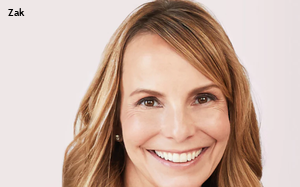Commentary
ThirdLove Dives Into Swim
- by Sarah Mahoney , Staff Writer @mahoney_sarah, December 11, 2023

Bathing suits are a notoriously complicated apparel category, especially for digital brands. Yet ThirdLove, now in its tenth year of excelling at online fit tactics, is taking the plunge. Heidi Zak, chief executive officer and co-founder, explains the decision to D2C Insider.
D2C Insider: Why introduce swim now?
Heidi Zak: Our customers have been asking for years. So we've had swim in development for some time, but it hasn't been the right moment. Swimwear is the No. 1 searched term on the site throughout the year. Our sports bras came about similarly two years ago.
We're listening, and this is customer-driven. And the swim market is highly fragmented, lacking bra tops that focus on support and fit. So what we’re launching is a swimsuit top based on the frame of our 24/7 T-shirt bra, complete with half-cup sizes. It provides the fit and support you get from your favorite bra in a swim top.
D2C Insider: What makes swimwear so hard?
Zak: The same reasons making a great-fitting underwire bra is hard. It's highly technical. Then layer on the need for suitable fabrications and foam for swim, and it’s not that easy.
D2C Insider: Right now, the line is only available in black. Why?
Zak: We had quite an internal debate. I pushed on this because we first need to learn about fit through customer feedback. And every woman needs a black bathing suit. Is there a woman out there who doesn't have one? It's like that little black dress in your closet. We’ll add colors eventually, but we wanted to start with what’s ubiquitous.
D2C Insider: Will you move on to one-piece suits?
Zak: We’ll get there over time. The feedback we’ve gotten so far has much to do with torso length, and we think there’s a real opportunity. We’re focused on fit and what we can uniquely bring to swim that other brands can’t.
D2C Insider: Will you do much advertising?
Zak: There will not be a huge push, although we’ll do some in the first quarter. For now, it’s meant to be for our repeat customers.
D2C Insider: ThirdLove is turning 10 this year, and the D2C world has changed so much, with many companies struggling to maintain growth. How is the company faring?
Zak: It's been a great year. We don’t disclose sales, but we are profitable. I still think being digital-first is something to be proud of. And we’ve built a brand with great products and tech, so women know what we stand for. I wouldn't say anything's dramatically shifted for us in terms of where we’re marketing, but we’re focusing on all the things that we know work, making sure our differentiators come through.

D2C Insider: There have been many changes in the last few years. The pandemic changed the way people dress. And many in Gen Z prefer bralettes. What do you see ahead?
Zak: Even though we’re still a wired bra company, we’re seeing a shift into wireless. It’s growing. But we also see a swing back to wired and a pick-up in strapless. Women are going out more. There's more inclusive sizing across the industry. I think we impacted the market in that way.
There’s much more interest in sustainability and sustainable fabrics. And we’ll continue the donation program, which has been important to our brand. We've donated $50 million worth of products since we started. That's a big deal in an industry that still sends many products to landfills.
D2C Insider: Who do you consider your main competitors? Is it other digital brands, like True & Co. or Adore Me, which was recently acquired by Victoria’s Secret? Or Victoria’s Secret and other physical retailers?
Zak: It's still Victoria's Secret, which we know from our FittingRoom platform. We've had over 20 million women do our FittingRoom quiz, and we ask where the bra they are wearing came from. Victoria's Secret is still the No. 1 answer. We may have a business model similar to that of Adore Me, but we don’t have similar customers.
D2C Insider: Many people prefer to buy a bra they can try on in person, and you’ve opened some stores. What have you learned?
Zak: At one point, I did say we’d never have stores, but I have come around to this idea. Now we have eight. They are all different formats and sizes and use different merchandising strategies. Some are street locations, and some are in malls. They’re doing well, and we have a high conversion rate. They build brand awareness. Most women who come in have heard of us but want to try something on in person. Some women want that store experience with in-person fit stylists. That's important.
D2C Insider: For many D2C companies, the next step would be moving into a company like Nordstrom, Macy’s or Target. Will that happen?
Zak: We’re open to it, but it hasn’t been our focus. Now, 100% of our revenues come from our channels, and that’s unique for a brand of our scale.



